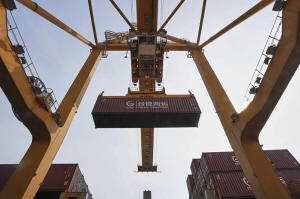Trump's trade demands go beyond tariffs to target perceived unfair
practices
[May 05, 2025] By
DAVID McHUGH, CHRISTOPHER RUGABER and YURI KAGEYAMA
FRANKFURT, Germany (AP) — The Trump administration says the sweeping
tariffs it unveiled April 2, then postponed for 90 days, have a simple
goal: Force other countries to drop their trade barriers to U.S. goods.
Yet President Donald Trump’s definition of trade barriers includes a
slew of issues well beyond the tariffs other countries impose on the
U.S., including some areas not normally associated with trade disputes.
Those include agricultural safety requirements, tax systems, currency
exchange rates, product standards, legal requirements, and red tape at
the border.
He’s given countries three months to come up with concessions before
tariffs ranging from 10% to more than 50% go into effect. Tariffs on
China are already in effect.
On many issues it will be difficult, or in some cases impossible, for
many countries to make a deal and lower their tariff rates.
In addition, many trade officials from targeted countries say privately
that it isn’t always clear what the Trump administration wants from them
in the negotiations.
Vice President JD Vance announced that India has agreed to the terms of
trade talks with the United States, but other countries are still trying
to set the contours for any negotiations. The White House has
highlighted conflicting goals for its import taxes: It’s seeking to
raise revenues and bring manufacturing back to the U.S., but it also
wants greater access to foreign markets and massive changes to other
nations’ tax and regulatory policies.
Here are several non-tariff areas the administration is targeting:

CURRENCY EXCHANGE RATES
Trump has accused Germany, China and Japan of “global freeloading” by —
in his view — devaluing their currencies to make their exports cheaper.
The European Central bank has been cutting interest rates to support
growth. That could also weaken the euro, which has strengthened sharply
against the dollar since Trump took office. The ECB says it doesn't
target the exchange rate.
In Japan’s case, the Bank of Japan has been gradually raising rates
anyway after keeping them at zero or in negative territory for years,
which should drive the yen up against the dollar. The U.S. dollar has
fallen recently to 140-yen levels, down from about 160 yen last summer.
Shrikant Kale, a strategist at Jefferies, believes the dollar will fall
to 120 yen over the next 18 months.
FARM PRODUCTS
Agricultural safeguards against importing pests or health hazards have
been a sticking point with U.S. trade partners for years. They include
Japan’s restrictions on rice and potato imports, the EU’s ban on
hormone-treated beef or chlorine-disinfected chickens and Korea’s ban on
beef from cows more than 30 months old.
Yet changes face stiff political resistance from voters and farm lobbies
in those countries.
For years, U.S. potato growers have sought access to Japan’s potential
$150 million market for table potatoes. Japan has engaged in talks but
taken years simply to supply a list of concerns to U.S. negotiators. The
delay is “pure politics,” intended to protect domestic growers, says
National Potato Council CEO Kam Quarles. If Japanese politicians
perceive the pain from Trump’s tariffs might be worse than from their
own potato growers, “that makes it more likely to make a deal,” Quarles
said.
But “if they perceive the pain domestically will be worse than the Trump
administration can bring to them ... we’re going to be stuck where we
are."
Korea’s beef restrictions started as a measure to keep out bovine
spongiform encephalopathy, or mad cow disease. The 30-month rule has
been maintained in the wake of mass protests in 2008, even as the U.S.
has become the largest beef exporter to Korea.
“It’s still politically controversial because of the scar at the time in
2008. I think the government will be very cautious,” said Jaemin Lee,
professor of law at Seoul National University and an expert on trade
issues.

TAXATION
Trump has railed against value-added tax as a burden to U.S. companies,
although economists say this kind of tax is trade-neutral because it
applies equally to imports and exports. Value-added tax, or VAT, is paid
by the end purchaser at the cash register but differs from sales taxes
in that it is calculated at each stage of the production process.
[to top of second column] |

Cranes work on stacks of containers at the Bangkok Port in Bangkok,
Thailand, Thursday, April 10, 2025. (AP Photo/Sakchai Lalit, File)
 Trump’s view could mean higher
tariffs for Europe, where individual countries levy VAT of 20% or
more depending on the type of good, and for the more than 170
countries that use this kind of tax system. The U.S. is an outlier
in that it doesn’t use VAT; instead, individual states levy sales
taxes.
There’s little chance countries will change their
tax systems for Trump. The EU for one has said VAT is off the table.
“The domestic taxation system has not been a conventional topic in
trade negotiation because domestic taxation is directly related to
national sovereignty or the domestic economic regime,” trade expert
Lee said. “It’s very hard to understand why VAT has become an
important topic in the trade discussion.”
PRODUCT STANDARDS
U.S. officials have complained about Japan’s non-recognition of U.S
vehicle safety standards and its different testing procedures for
car equipment.
Japan also provides subsidies for the Japanese-designed ChaDeMo plug
standard for electric cars, requiring foreign makers to use an
outdated technology if they want the subsidy.
BUREAUCRACY
Concerns about excessive or baffling bureaucratic procedures to get
goods into a country are mentioned repeatedly in the
administration’s latest trade assessment. The U.S. has complained
about expensive delays getting permission to export seafood to
Japan. Meanwhile, Japan requires wheat imports to be sold to a
government entity and has “highly regulated and intransparent” quota
system that keeps rice imports from the U.S. to a minimum.
Most of these issues are years old, raising questions about whether
90 days is enough to make a deal over them.
U.S. pharmaceutical companies have complained about Korea’s system
for drug imports, while automakers say environmental equipment
standards are unclear and expose only importers to criminal
penalties in case of violations.
BUY AMERICAN
Analysts say that despite the long list of non-tariff issues, the
administration’s main focus may lie elsewhere: on Trump’s desire to
reduce trade deficits, cases where a country sells more to the U.S.
than it buys.
And the solution may be other countries buying more U.S. products,
from energy to soybeans, and builingd more plants in the U.S.

U.S. energy is already a major export to Europe. Trump has mentioned
a figure of $350 billion for potential EU gas imports. The EU does
need imported gas. But Trump's figure would be a stretch given that
last year’s exports of liquefied natural gas to the EU were around
$13 billon, and that Europe is seeking to reduce its use of fossil
fuels over the longer term.
THE HEART OF THE MATTER?
Discussions about non-tariff issues may simply be leverage to
underpin Trump’s stiff tariff levels.
“It’s just a thing that’s there to justify my tariffs,” said Tobias
Gehrke, senior policy fellow at the European Council of Foreign
Relations.
While lower level trade officials and industry representatives are
acutely aware of non-tariff issues like agricultural safety, “Trump
and his cabinet... don’t really care about chlorinated chicken
regulations in Europe and food standards," Gehrke said. “They have
much bigger thinking.”
“They want to have European companies significantly move production
to America... and to export from America to Europe. That would
change the trade balance.”
“And if that’s the main logic, then there’s no real deal to be had
on non-tariff barriers.”
___
Rugaber contributed from Washington DC and Kageyama from Tokyo.
All contents © copyright 2025 Associated Press. All rights reserved |